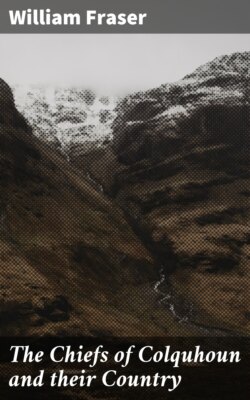Читать книгу The Chiefs of Colquhoun and their Country - Fraser William Alexander - Страница 20
На сайте Литреса книга снята с продажи.
III.—MAURICE, Third of Luss [1250-1280].
ОглавлениеTable of Contents
Maurice is the next laird of Luss that appears on record. “Mauritius de Luss” was witness to a charter by Maldouen Earl of Lennox to Maurice, son of Galbraith, and the heirs of his marriage with Katharine, daughter of Colpatrick, of a carucate of the land of Cartonvenach; and to another charter by the same Earl in favour of the said Maurice, and Arthur his son, of a fourth part of land in Auchincloich, in exchange for other lands.[1] He was a witness to a charter by the same Earl, in 1250, granting to the monastery of Paisley in pure, free, and perpetual alms, one pasture of land of Levenax, and to the monks thereof the right to hold and possess all other their lands in the earldom of Levenax, as they held them at the time of this grant, or before.[2] He was also a witness to a charter by Engus, son of Duncan, confirming to the monks of Paisley the church of Kyllinan, dated 5th March 1270.[3] He appears again as a witness to a charter by Gillemichell, son of Edolf, to Malcolm his son, of the lands of Gartchonerane, and to two confirmations of that charter, one by Duncan, son of Gillemichel Makedolf, and the other, which is dated 17th November 1274, by Malcolm Earl of Lennox.[4]
On 17th August 1277, Maurice, as Laird of Luss, for a certain sum of money, made a charter, granting to God and the blessed St. Mungo and the church of Glasgow the right of cutting and preparing out of any parts of his woods of Luss whatever should be necessary for the woodwork of the steeple and treasury, which the chapter of the Cathedral of Glasgow, in consequence of its growing wealth and importance, was then in the course of erecting, with free access thereto and egress therefrom, and liberty of pasturage for the horses, oxen, and other animals which should be employed in carrying the wood required.[5] In that age privileges of this description were generally granted gratuitously to the church by the proprietors of the soil from their devotion or their fears; but on the part of this Celtic laird, it was a purely mercantile transaction. In granting this privilege he does not even affect to have been governed by a higher motive than the reception of its value in money; though, in conformity with the language of the time, the charter is said to be granted “to God and the blessed St. Mungo, and the Church of Glasgow.”
Maurice of Luss is said to have had issue—
1.
John, who succeeded him.
2.
William of Luss, designed vicar in a document dated 1313, may have been his son.[6]
| [1] | Cartularium Comitatus de Levenax, p. 27. |
| [2] | Registrum Monasterii de Passelet, p. 172. |
| [3] | Ibid. p. 134. |
| [4] | Cartularium Comitatus de Levenax, pp. 84-86. |
| [5] | Registrum Episcopatus Glasguensis, vol. i. p. 191. |
| [6] | Registrum Monasterii de Passelet, p. 376. |
